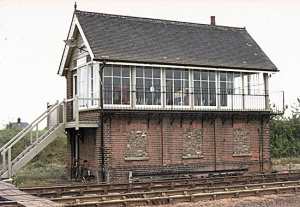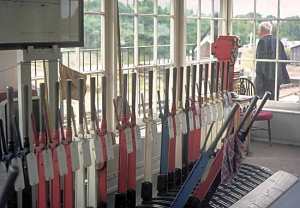Crouch Valley Railway Line
The Crouch Valley line is a branch line running 16.5 miles from Southminster to Wickford.
Stations on the line are Battlesbridge, South Woodham Ferrers, North Fambridge, Althorne, Burnham-on-Crouch, Southminster.
Regular electric trains run on the line which include through trains to London Liverpool Street at busy periods.
The line were also used to convey used rods from nearby Bradwell nuclear power station to Sellafield.
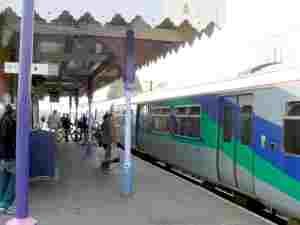 Burnham Railway Station 2007
Burnham Railway Station 2007
Construction
The 16.5 mile line was built by Great Eastern Railway opening to Goods traffic on 1 June 1889 and to passengers a month later.
The main engineering contractor for the construction of the Southminster branch was Walter Scott and Co of Newcastle who employed the noted engineer Thomas Middleton to build the stretch from Althorne to Southminster
Over 500 navvies were involved in the construction which cost a total of nearly 1/2 million pounds and involved moving over 2.5 million yards of soil.
Building the railway line brought with it other problems. In 1889 the Medical Officer for Health for Burnham reported that the large number of navies now lived in the Parish which had resulted in a rise in the number of deaths to 15 partly caused by the introduction of diphtheria.
The Railway Stations and other buildings at Burnham were erected at a cost estimated as between 2 and 3 thousand pounds.
The line took about two years to build with materials shipped in to a quay at Stokes Hall, Althorne by Thames barge from brick fields in Kent.
New bridges were constructed in 1887 at Church Road, Burnham on Crouch and Ferry Road, Creeksea.
The opening day of the line was threatened by neighbouring Maldon after traders and the Council petitioned the directors of GER to delay the opening of the Southminster line until the branch extension to South Maldon was able to open and they were worried that trade from the Dengie Hundred would flow out to London via Wickford rather than pass through Maldon as had previously been the case. The petition was rejected by the GER management.
Opening Day for passenger trains
On 1 July 1899 the
first passenger train with 12 carriages departed from Southminster
at 8.15am and reached Wickford punctually at 9.04am without the
slightest mishap. Crowds assembled at stations en route with 50
people embarking at Southminster.
In order to make the day a memorable one in the lives of local children benefactors (Southminster Mr J S Prior and at Burnham Messrs.' A B and W A Croxon)
paid for over 500 local children, aged from 5 to 12 years, to ride to Wickford and back on the first operating day. A special train was laid on for the children with two engines and 17 carriages.The 11.25am train from Wickford included a
saloon carriage in which the GER Official travelled. On their
arrival at Southminster the local schoolchildren, all waving flags,
formed an alleyway through which passengers on the train left the
station.
After a reception at Southminster Hall a complimentary banquet was given in a marquee near to Southminster Railway Station for Officials of the Railway , the
contactors and local representatives. Guests included Major Rasch MP and Mr C H Parkes Chairman of GER.Click here to view the names of the people attending the banquet.
After the reception the guests departed on
the 5.30 train.
Local shops at Burnham and Southminster were
decorated with bunting and many closed at 1pm so that the
shopkeepers could join in the festivities.
During the afternoon, all along the line,
the trains were crowded with people, many of whom were taking their
first trip on a train. The booking offices at Southminster and
Burnham were besieged by customers as the time for departing trains
approached with both platforms becoming very crowded..
Throughout the day the streets of
Southminster were crowded and it was reported that a large volume of
business was done by the various hostelries so that the proceedings
passed of very successfully.
The Southminster public enjoyed a flower
show in an adjoining field with fine displays of local flowers,
plants, fruit and honey in hotly contested classes. There was plenty
of amusement in swings, shows and a band. Even with an entry charge
of six pence the show drew a large crowd. In the evening an
athletics contest, followed by a grand fireworks display completed a
fine day.
On the first day 1,622 tickets were sold on the
line of which 1,500 were purchased at Southminster or Burnham on
Crouch.
Operating the Line
On Saturday 13 July 1889 the first railway excursion arrived at Burnham on Crouch Railway Station from London for a fare of 1sh & 6p. The visitors enjoyed boat trips on the river and strolls along the Quay. It was reported that some visitors were disappointed as they stayed on the train to Southminster in the belief that they would get a sea view from there.
In 1889 a first class ticket from Burnham on Crouch to London was 8s 8d (44pence) and a second class ticket was 4s 4d ( 22 pence).
The through trains to London initially terminated at Fenchurch Street but this changed to Liverpool Street with a traveling time of 1 hour 42 minutes. To people used to walking or horse and carts this was really fast travel.
GER became part of LNER ( London and North Eastern Railways) in 1923 although the rolling stock, staff and stations operated unchanged.
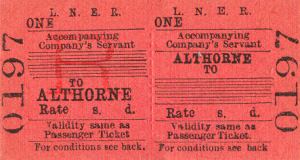 a Ticket from Althorne in the old LNER days.
a Ticket from Althorne in the old LNER days.
Goods Traffic
The line opened for
goods traffic with the departure of a train from Southminster
Railway Station at 4pm on 1 June 1899. One train a day was scheduled
to run as a luggage train with other good trains running for
specific purposes.
A large crowd assembled to see the train and
watch as Mr James Gale and Mr Charles Croxon loaded a total of 100
shearlings, wool bound for Wales and other packages loaded by Messrs
Samuel Pipe, J S Prior and W Harvey. The train stopped at Burnham on
Crouch, which was decorated with bunting. The train was greeted with
cheering from a large crowd of people. Freight was loaded by Messrs
W Newman, J Camping, W Carter, A Newman and other traders.
Goods traffic was very important as shown by
sidings at several Stations on the line.
Southminster Market was held 9 times a year in relation to horses (not at Christmas or harvest) and weekly for the cattle.
Each market day,
trains with 10 or more cattle wagons left Southminster for Wickford.Regular goods services were required to service the Mildmay Ironworks at Burnham on Crouch and a sugar beet train that left Burnham sidings at 6pm each weekday during the sugar beet season.
Click here for details of the ironworks.
World War One
During World War I the Dengie became a front line area and the railways played an important part in transporting troops and materials.
Click here for details of WW1 in the Dengie 100.
Proposed Extension
Between the wars a number of schemes were proposed to extend the Crouch Valley Line including bridges at Creeksea to reach Southend and a bridge over the River Blackwater at Bradwell via Mersea Island to reach Colchester.
None of the schemes came to fruition although traces of the preliminary work can be found at Fairhaven Avenue, West Mersea and on some old maps this road is called Station Road.
World War Two
World War 2 once more turned Dengie into a front line area and the Crouch Valley Line again became the central supply line.
The Army, Navy and RAF were all well represented and so service vehicles, 'liberty buses' and Service Uniforms became familiar features at Southminster and Burnham Railways Stations.
Click here for details of Dengie in WW2
After the Wars
In 1948 the railways were nationalised and Great Eastern gave way to British Rail- Eastern Region.
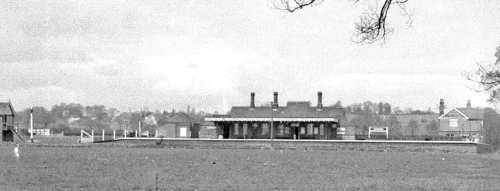
Althorne Railway Station is pictured in 1956 - Picture supplied local transport expert, Brian Pask who holds copyright on the picture
In 1957 a new prosperity came to the line with construction work for the new nuclear power station at Bradwell on Sea.
In 1964 the line survived the ' Beeching Axe' which had closed so many other small branch line including the nearby Maldon to Witham line.
The need for nuclear waste trains and the ballast trains from pits between Burnham and Southminster seem to have been the deciding factors in not only keeping the line alive but in its eventual electrification in 1986.
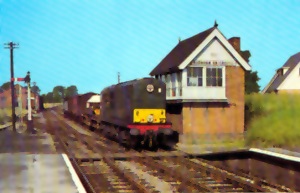 Burnham signal box before
electrification
Burnham signal box before
electrification
The negative effect of the review was the closure and removal of the goods sidings at all stations other than Southminster and the demolition of the majority of station buildings .
|
SOUTHMINSTER |
Signal Boxes
John Hinson runs a site called THE SIGNAL BOX dedicated to Railways with emphasis on signaling.
He has been kind enough to give me permission to use the photographs on Southminster Signal Box. If this interests you please visit his site for more fascinating details.
|
Great Eastern Railway -Southminster Signal Box
|
|
|
Opened: 1889 |
Closed: c1991 |
Location code: E35/23 |
|
Southminster is the terminus of a surviving branch line which turns of the Great Eastern's line to Southend Victoria at Wickford. All of the boxes in this area that dated from the lines' opening in 1889 were a variation on the Great Eastern's final standard of 1885 onwards by having more steeply pitched roofs and other ornate features. All boxes of this type were built by McKenzie & Holland.
|
|
|
As might be expected, the interior view is dominated by a McKenzie & Holland frame of 36 levers, a common type used by many railway companies. No block shelf is provided - this was not necessary because there were no block instruments to place on it. The single line is controlled by the Miniature Electric Train Staff instrument mounted upon a sturdy cupboard in the far corner. The line was electrified and resignalled around 1991, but the lever frame seen here was transferred to the nearby Mangapps Farm Railway Museum, where it has been reassembled so that visitors can operate it and examine the workings. |

